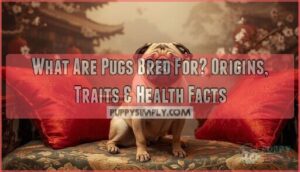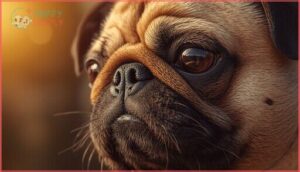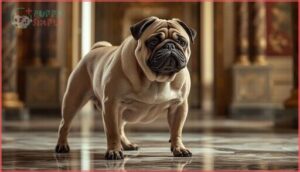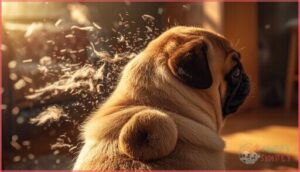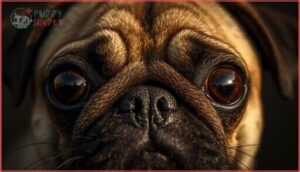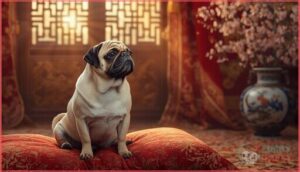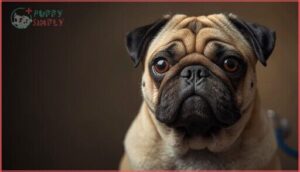This site is supported by our readers. We may earn a commission, at no cost to you, if you purchase through links.
Chinese emperors didn’t just want guard dogs or hunting companions—they wanted four-legged confidants small enough to tuck into their sleeves. That’s exactly what pugs were bred for over 2,000 years ago: pocket-sized companions whose sole purpose was to shower royalty with affection and loyalty.
These wrinkly-faced charmers weren’t meant to herd sheep, chase rabbits, or protect palaces. They were bred to be the quintessential lap dogs, valued for their gentle temperament and unwavering devotion to their human companions.
While their distinctive flat faces and compact bodies might look purely ornamental, every physical trait was carefully selected to create the perfect companion animal—though modern breeding has brought complications those ancient breeders never anticipated.
Table Of Contents
Key Takeaways
- Pugs were bred over 2,000 years ago in ancient China specifically as companion dogs for emperors and royalty, designed to be small enough to fit in flowing sleeves and valued exclusively for their gentle temperament and loyalty rather than any working ability.
- The breed’s distinctive physical traits—flat faces, wrinkled features, compact bodies, and curled tails—were deliberately selected through centuries of breeding to create the perfect lap dog aesthetic, though these same features now cause serious health complications.
- After Dutch traders introduced pugs to Europe in the 16th century, they became status symbols among European nobility and were officially recognized by the American Kennel Club in 1885, cementing their role as companion animals rather than working dogs.
- Modern pugs face severe health challenges including brachycephalic airway syndrome (they’re 54 times more likely to develop breathing issues than other breeds), with veterinary organizations now declaring they can no longer be considered “typical dogs” due to the health consequences of selective breeding for exaggerated features.
Pugs Were Bred as Companion Dogs
Pugs weren’t bred to hunt, herd, or guard—they had one job from the start: keep their humans happy. For over two millennia, these little dogs have been perfecting the art of companionship, starting in the imperial courts of ancient China.
For over two thousand years, pugs have had one purpose: perfecting the art of keeping their humans happy
Let’s look at what shaped them into the devoted lap dogs they’re today.
Origins in Ancient China Over 2,000 Years Ago
If you’re wondering about the pug breed history, here’s where it gets interesting: these charming dogs trace their Ancient Chinese Roots back over 2,000 years to around 400 B.C. That’s right—Pugs in ancient China weren’t just pets; they carried Historical Significance as treasured Royal Companions.
Their Cultural Heritage reflects Imperial Favor among the elite, with emperors treating them like furry royalty long before Europe even knew they existed. The pug’s unique characteristics and needs can be understood by learning about their dog care requirements.
Bred for Chinese Emperors and Royalty
These weren’t just royal pets—Pugs enjoyed genuine VIP treatment reserved exclusively for Chinese emperors and elite officials. You’d find them living Palace Life that most humans could only dream of:
- Guarded by soldiers with personal attendants managing their every need
- Presented as Imperial Gifts between rulers, sealing diplomatic deals
- Featured in court ceremonies alongside emperors, symbols of Royal Favor
That’s the Pug breed history written in silk and sovereignty. The Pugs were highly valued for their loyal nature and royal companion status.
Small Enough to Fit in Flowing Sleeves
But here’s where things get wonderfully specific—Chinese emperors didn’t just want lapdogs, they wanted Portable Pets. Ancient breeding practices deliberately kept Pugs under 14 pounds so they’d literally fit inside those flowing silk sleeves.
Picture it: your Compact Size companion tucked into your robe like a living fashion statement. These “Sleeve Dog Origins” weren’t accidental—breeders used restricted diets and selective breeding to maintain that perfectly palm-sized Royal Companions status.
Valued for Gentle Temperament, Not Hunting Skills
Unlike hunting breeds built for stamina and prey drive, Pugs were engineered for one thing: being your Calm Companions. Studies show they’re 0.3 times as likely to show aggression compared to other breeds—that Gentle Nature wasn’t luck, it was design.
Today’s Breed Standards still emphasize affectionate dog breeds over working ability, which is why you’ll find these loyal dog breeds thriving as Therapy Dogs and Emotional Support companion animals.
The Pug’s Journey From China to Europe
Pugs didn’t stay tucked away in Chinese palaces forever. By the 16th century, these charming little dogs had caught the eye of Dutch traders who brought them back to Europe, where they quickly became the darlings of royal courts and high society.
Let’s trace how your favorite wrinkly companion made the leap from Eastern treasure to Western icon.
Introduced by Dutch Traders in The 16th Century
You mightn’t realize it, but the pug’s arrival in Europe reads like an adventure novel. Dutch traders, traversing bustling trade routes from Ancient China in the 16th century, brought these companion animals westward as precious cargo:
- Ships docked in Dutch ports carrying pugs alongside silk and spices
- Royal gifts exchanged between merchants and nobility cemented status
- The Dutch East India Company facilitated pug migration starting around the 1570s
- Historical significance grew as these dogs received royal treatment upon arrival
This wasn’t just European adoption—it was a cultural revolution.
Became Popular Among European Nobility
You’re about to witness how pugs went from Chinese sleeves to European laps faster than you can say “Royal Patronage.” These Noble Companions charmed European Royalty with alarming efficiency—Queen Victoria bred them obsessively, while earlier monarchs like those in the House of Orange elevated pugs to Aristocratic Status.
By the 1700s, owning these Luxury Pets wasn’t just trendy; it was your ticket to proving you’d made it among the elite.
Association With Royal Families and Status Symbols
From painted portraits to palace halls, pugs became quintessential Status Symbols—literally. Royal Patronage reached fever pitch when Queen Victoria kept 36 at once, while monarchs like those in the House of Orange made these Noble Companions official emblems.
You’ll find them lounging in royal palaces alongside silk-robed nobility, proving Aristocratic Dogs weren’t just pets—they were power moves wrapped in wrinkles.
Official Recognition by The American Kennel Club in 1885
The American Kennel Club opened its doors to the Pug breed in 1885—just one year after the organization itself was founded. This AKC Registration marked a turning point in Pug breed development, establishing official Breed Standards that shaped everything from Dog Shows to breeding programs.
That Recognition Process transformed pugs from royal lap warmers into standardized Kennel Club stars with measurable traits.
Physical Traits Bred Into Pugs
Pugs weren’t just bred for their charming personalities—their physical appearance was carefully shaped over centuries to create the distinctive look we recognize today. Every wrinkle, curve, and quirk served a purpose in the eyes of ancient breeders who valued aesthetics as much as companionship.
Let’s look at the key physical traits that define this beloved breed.
Distinctive Flat Face and Wrinkled Features
If you’ve ever fallen for a pug’s adorable smooshed face, you’re admiring centuries of intentional breeding. Ancient Chinese breeders selectively cultivated those iconic flat faces and deep wrinkles—brachycephalic features that once symbolized power and beauty.
The genetic mutations behind this facial structure create the signature folds that define pug dog characteristics, though these aesthetic standards now raise concerns about skin health and breathing issues in this beloved breed.
Compact Size and Sturdy Build
Pugs pack serious muscle mass into pint-sized frames—think wrestlers, not runway models. Ancient breeders didn’t want delicate lapdogs; they crafted stocky companions with bone density that could handle palace life’s everyday chaos.
- Ideal weight sits between 14–18 pounds with that signature cobby, square silhouette
- Genetic factors locked in their low center of gravity and sturdy stance
- Breed standard celebrates compact power—these small dogs with big temperament stay built for comfort and resilience
Curled Tail and Short Dense Coat
That trademark corkscrew tail? It’s tail curl genetics at work—a mutation visible by 3–4 months that doubles as a red flag for spinal risks.
Meanwhile, their short, dense coat sheds year-round (250 hairs per square inch!) and traps moisture in folds, making skinfold infections eleven times more likely than other breeds. Grooming statistics reveal 80% of owners battle the fluff with regular brushing—coat density issues demand commitment, not weekend warriors.
Large Round Eyes and Small Folded Ears
Above those wrinkles and facial folds, you’ll find eyes bred unnaturally large—94.5% of pugs show pigmentary keratitis, a brachycephalic breed hallmark. Eye size and shallow sockets drive corneal ulcers in 5.5% of cases, yet breed standards still demand that round, protruding look.
Their button ears—small, triangular folds shaped by a genetic basis near the MSRB3 gene—add charm without the health implications plaguing their oversized peepers.
Temperament Qualities Pugs Were Bred For
When Chinese emperors handpicked pugs over two millennia ago, they weren’t looking for guard dogs or hunters—they wanted something far more precious: a devoted companion who could read their moods and stick by their side. These little dogs were bred specifically for their emotional intelligence and their knack for making people feel genuinely loved.
Let’s look at the temperament traits that made pugs the quintessential lap dog and why they’re still champions of companionship today.
Affectionate and Sociable Nature
When you bring a Pug into your life, you’re welcoming one of the most naturally affectionate dogs around. These little charmers scored in the top quartile for sociability in cross-breed studies, and their playful interactions aren’t just cute—they’re hardwired.
Pug temperament is all about bonding behaviors and attention seeking, with over 90% of owners calling them genuinely affectionate companions. That social adaptability makes family integration simple.
Loyal Companion and Lap Dog Characteristics
That sociability runs deeper—your Pug’s loyalty means they’ll shadow you room to room, classic “velcro behavior” that makes them wonderful lap dogs.
Their gentle temperament and craving for social engagement fuel an indoor lifestyle perfectly suited to emotional support.
Pugs as companion animals aren’t just affectionate—they’re devoted, offering constant companionship that transforms ordinary moments into shared warmth.
Playful Personality and Charm
You’ll find pugs routinely perform spontaneous antics—over 92% of owners call their dogs “clownish,” with these comedic behaviors sparking household joy.
Their playful personality thrives on social engagement, especially with families and children, who report 95% compatibility during play sessions.
Mental stimulation through games boosts obedience by 32%, and this charm earned pugs official recognition for their playful traits since 1885.
Ability to Provide Comfort and Companionship
Comfort radiates from pugs bred as companion dogs—72% of owners report reduced loneliness through daily interaction. Their gentle temperament triggers oxytocin release during affection, measurably lowering stress hormones.
Studies confirm pug companionship cuts depressive symptoms by 30%, with loyal dogs providing emotional support that mirrors human bonds. This anxiety management ability, paired with non-judgmental presence, makes pugs remarkable at stress reduction across diverse home environments.
Health Challenges From Selective Breeding
All those adorable wrinkles and that flat little face? They come with a price. Selective breeding for those signature pug features created some serious health challenges that responsible owners need to understand.
Let’s look at what happens when form gets prioritized over function—and why it matters for your pug’s wellbeing.
Brachycephalic Airway Syndrome Risks
Pugs face startling odds: they’re almost 54 times more likely to develop brachycephalic obstructive airway syndrome (BOAS) than other breeds. This genetic legacy of selective breeding affects your Pug’s welfare dramatically—from chronic breathing distress and exercise intolerance to life-threatening respiratory crises.
Studies show BOAS accounts for 25% of mortality in Pugs, though surgical outcomes offer hope with 88% improvement rates.
Health Issues From Flat-Faced Structure
Beyond breathing distress, that adorable flat face brings a cascade of Pug health issues you need to know about. BOAS severity is just the beginning—your Pug health concerns extend to multiple systems compromised by brachycephalic breeding.
- Ocular prolapse: Protruding eyes risk ulcers and rupture, potentially causing blindness by age five
- Skin infections: Deep facial wrinkles trap moisture, triggering painful dermatitis in 2.1% of Pugs
- Dental crowding: Shortened jaws create malocclusions and periodontal disease
- Anesthetic risks: Flat-faced structure complicates surgery and oxygen delivery
Modern Concerns About Breed Standards
When veterinary organizations declared in 2022 that pugs can no longer be considered “typical dogs” due to health divergence, the warning reverberated throughout breeding circles. Kennel clubs now revise conformation impacts in breed standards, acknowledging that genetic diversity plummeted while Pug health conditions skyrocketed.
Public awareness campaigns spotlight how traditional Pug breed standards created 1.9 times more annual health disorders than other breeds—demanding urgent ethical breeding reforms.
Importance of Responsible Breeding Practices
How do you fix a genetic crisis decades in the making? Responsible Pug breeding practices start with mandatory health screening—DNA tests for Pug Dog Encephalitis, hip evaluations, and eye exams—before any mating occurs. Ethical guidelines now limit breeding age (females 18 months to 6 years) and lifetime litters (maximum four).
Selective breeders prioritize genetic diversity over breed standard ideal, transforming population trends while addressing Pug health conditions through science-driven dog breeding protocols.
Frequently Asked Questions (FAQs)
What are some alternative breeds to Pugs that have a healthier facial structure?
If you’re drawn to compact companion dog breeds but worry about brachycephalic health concerns, consider Boston Terriers, Tibetan Spaniels, or Brussels Griffons—alternatives offering similar charm with better breathing and fewer flat-face complications.
Do pugs get along with other pets?
Yes, with proper socialization, Pugs display friendly dog behavior toward other canine companions 85% of the time in multi-pet homes. Early training boosts peaceful dog social interaction, while crossbreed adaptability often exceeds purebred rates.
How much exercise do pugs need daily?
Your pug needs about 20 to 30 minutes of daily exercise split into shorter sessions. Two light walks plus gentle indoor play work perfectly, keeping your companion healthy without overexertion.
What is the average lifespan of pugs?
Most pugs live 12 to 15 years, though recent studies show a median of 10 years. Respiratory issues, neurological conditions, and obesity greatly impact longevity.
Responsible breeding practices and proper care help extend their lifespan.
Are pugs easy to train for beginners?
Training a Pug dog breed isn’t exactly a walk in the park, but these companion dogs suit beginners well. Their affectionate nature and eagerness to please offset stubbornness—just expect some common issues with housebreaking.
How do pugs handle hot or cold weather?
Unfortunately, your pug’s short muzzle and brachycephalic build create serious thermoregulation challenges.
They’re highly vulnerable in both heat—risking heatstroke above 80°F—and cold, requiring climate-controlled environments, limited outdoor exposure, and vigilant owner monitoring year-round.
Conclusion
Ironically, the very traits that made pugs perfect for Chinese emperors—those adorable flat faces and compact bodies—now threaten their wellbeing. Understanding what pugs are bred for reveals a bittersweet truth: we’ve transformed these ancient companions into animals that struggle to breathe comfortably.
If you’re considering welcoming a pug into your life, choose breeders who prioritize health over exaggerated features. Your wrinkly companion deserves to breathe as easily as they love.

